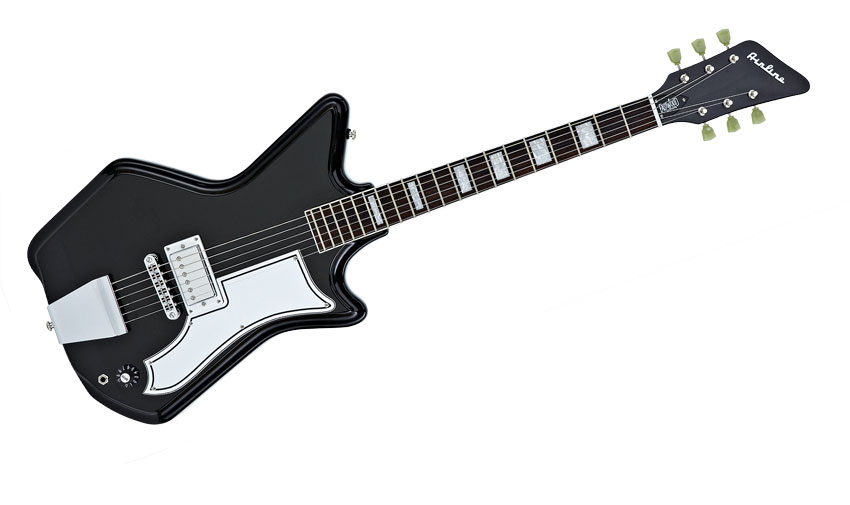MusicRadar Verdict
A leftfield, funky treat of a guitar that feels and sounds quite inspirational.
Pros
- +
Bags of potential for sonic adventurers. Unusual looks and design. Well spec'd.
Cons
- -
Low feedback threshold and semi-solid feel may deter some.
MusicRadar's got your back
Eastwood unashamedly raids the back catalogues of long-defunct guitar companies and fills a sizeable hole in the market. This Airline repro is a perfect case in point. What were they thinking back in the day?
Build
"Under the glossy opaque finish, it's actually quite hollow - the body is routed out leaving a block under the bridge and lower body"
Originally, of course, the body was made of plastic; here it's 'chambered mahogany'. But under the glossy opaque finish, it's actually quite hollow - the body is routed out leaving a block under the bridge and lower body, but forward of that it's pretty airy; it's sealed with a thin 5mm top. The contrasting white rubber fillets around the edges - originally used to join the two moulded halves of the hollow body - are retained, as is the original light weight.
With its bound rosewood fingerboard, pearloid block inlays and coach-lined white scratchplate, it's an entirely flashier affair than its puritanical single-pickup rivals the Fender Esquire and Gibson Les Paul Junior. The chamfered edges follow the shape of the original moulded body and the neck is a bolt-on with four recessed screws and no neck plate.
Hardware is quality, too, with Wilkinson Deluxe Kluson-like tuners, which are nice and smooth in use, a Tone Pros locking tune-o-matic-style bridge and a solid trapeze tailpiece with just enough flex for vibrato effects.
A single humbucker-size covered pickup with no label ID underneath is controlled by a lone volume knob placed (too) close to the top-mounted output jack. Strangely, in the guitar's spec, the pickup is referred to as a 'single-coil' and with a DC resistance reading of 6.75k ohms, it probably is.
The neck shape is a broader-feeling, slightly thinner-depthed flatter 'C' than the Esquire, with a flatter fingerboard radius and bigger frets, a very different flavour to the Fender.
Sounds
Plug in the Airline and, yes, it seems we do have a single-coil, judging by the hum and general sound. It's reasonably hot in output, but doesn't go overboard with high-end zing and offers a decent fullness.
In fact, it's instant Jumpin' Jack Flash: beautiful for 60s chime-y rock and pop, especially with the volume knocked back a touch, which smoothes the highs a little. It's a nice feeling, lightweight guitar, too, though a tone control would really make a difference.
Heavier gains work well, there's a lower feedback threshold than a solidbody, and it's all too easy to get lost in old-school effects. It is a bit of a sleeper, really, and one that would suit more left-field sounds with a definite semi-solid unpredictability - a sonic mangler's dream?
The Eastwood Airline has grungy alt-rock written all over it, and any player who likes the different Jack White-approved vibe will take to this one instantly. If you lean on the more out-there, creative side of the tracks, this might suit you perfectly.
It's a little pricier than near rivals, but does include a tweed case and even some literal case candy in the form of an actual Curly Wurly... which we hope wasn't a bribe, because we scoffed it anyway.
Dave Burrluck is one of the world’s most experienced guitar journalists, who started writing back in the '80s for International Musician and Recording World, co-founded The Guitar Magazine and has been the Gear Reviews Editor of Guitarist magazine for the past two decades. Along the way, Dave has been the sole author of The PRS Guitar Book and The Player's Guide to Guitar Maintenance as well as contributing to numerous other books on the electric guitar. Dave is an active gigging and recording musician and still finds time to make, repair and mod guitars, not least for Guitarist’s The Mod Squad.
Arturia’s V Collection gets a Roland JP-8000 emulation and lo-fi synth/sampler, along with five more instruments and a host of updates
Capture the sound of The Last of Us season 2's haunting soundtrack with Spitfire Audio’s latest software instrument, Ronroco by Gustavo Santaolalla
“Nope, it’s real”: Jack Black and Keanu Reeves both confirmed for upcoming Weezer movie











